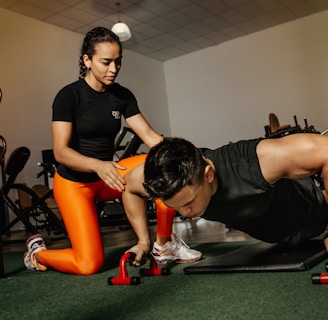10 Essential Tips for Building Muscle Naturally Through Healthy Diet and Exercise
3/11/20255 min read


Introduction
In the quest for enhanced physical fitness, individuals often seek effective and sustainable strategies for muscle development. A natural and holistic approach, rooted in scientific evidence, traditional wisdom, and mindful lifestyle practices, offers the most sustainable path to achieving muscular growth. This article presents ten essential principles for muscle development, integrating modern scientific research with ancient Ayurvedic insights. By adopting a well-balanced diet, structured exercise routines, and adequate recovery strategies, individuals can optimize muscle growth while maintaining overall well-being.
1. Embrace a Balanced and Nutrient-Dense Diet
Nutrition serves as the foundation for muscle growth. A diet rich in plant-based proteins, complex carbohydrates, and healthy fats provides essential macronutrients and micronutrients necessary for muscle repair and development. Ayurveda emphasizes Sattvic foods—natural, minimally processed, and nutrient-dense options such as legumes, whole grains, nuts, seeds, and dairy products like ghee and paneer (Sankar et al., 2021). Additionally, anti-inflammatory herbs such as turmeric and ashwagandha enhance recovery and muscle function.
2. Optimize Protein Intake for Muscle Synthesis
Protein intake plays a pivotal role in muscle growth, as it provides amino acids necessary for muscle repair and hypertrophy. Research suggests that consuming 1.2 to 2.2 grams of protein per kilogram of body weight daily is optimal for muscle development. Plant-based sources such as lentils, chickpeas, hemp seeds, and spirulina offer high-quality proteins with additional fiber and antioxidants. Ayurveda also recommends Mung Dal (green gram) for its digestibility and muscle-nourishing properties.
3. Maintain Optimal Hydration for Muscle Function
Hydration is often underestimated in its role in muscle function and recovery. Water facilitates nutrient transport, joint lubrication, and thermoregulation during exercise. Consuming herbal infusions with cooling and electrolyte-rich ingredients such as coconut water, Jeera (cumin) water, and Tulsi (holy basil) tea can further enhance hydration. Studies suggest that dehydration reduces muscle endurance and strength, highlighting the necessity of maintaining fluid balance.
4. Implement a Structured Resistance Training Routine
A well-designed resistance training program is crucial for muscle hypertrophy. Compound movements such as squats, deadlifts, and push-ups activate multiple muscle groups, promoting efficient growth. Incorporating bodyweight exercises, yoga asanas like Virabhadrasana (Warrior Pose), and Chaturanga Dandasana (Four-Limbed Staff Pose) strengthens muscles holistically. Resistance bands and free weights further diversify the training regimen.
5. Prioritize Adequate Recovery and Sleep
Muscle growth occurs not just during workouts but significantly during rest periods. Sleep, in particular, is essential for muscle repair and hormone regulation. Studies highlight that sleep deprivation reduces muscle protein synthesis and increases cortisol levels, leading to muscle breakdown. Ayurveda prescribes Brahmi and Ashwagandha as natural adaptogens that improve sleep quality and reduce stress-related muscle loss.
6. Increase Caloric Intake Through Nutrient-Dense Foods
To facilitate muscle gain, individuals must maintain a caloric surplus, consuming more calories than they expend. However, quality matters more than quantity. Ayurveda emphasizes Rasayana (rejuvenating foods) like almonds, dates, sesame seeds, and clarified butter (ghee) to provide sustained energy and muscle nourishment. Smoothies made with soaked nuts, plant-based milk, and flaxseeds serve as excellent energy boosters.
7. Monitor Progress and Adjust Accordingly
Tracking progress allows individuals to refine their approach. Utilizing fitness apps, journals, or biometric assessments ensures measurable improvements in strength and muscle mass. Regular self-assessments with photos and body composition analysis contribute to long-term motivation and success. Ayurveda recommends pulse diagnosis (Nadi Pariksha) as a method to assess metabolic health and muscle function.
8. Incorporate Exercise Variety to Prevent Plateaus
Muscle adaptation occurs when workouts are varied regularly. Incorporating different training modalities such as high-intensity interval training (HIIT), yoga, and Pilates enhances muscle engagement and flexibility. Functional training with resistance bands and kettlebells provides additional resistance without the need for heavy gym equipment. Further, Pranayama and Meditation brings harmony in body, mind and spirit.
9. Seek Expert Guidance for Personalized Growth
Professional guidance ensures a scientifically sound and effective approach to muscle building. A certified nutritionist or Ayurvedic practitioner can offer tailored advice on diet and supplementation, integrating ancient practices with modern sports science (source). Holistic muscle-building strategies include herbal supplementation, breathwork techniques (Pranayama), and meditation for stress reduction.
10. Commit to Consistency and Long-Term Discipline
Muscle development is a gradual process that demands patience, discipline, and persistence. The body adapts over time through progressive overload and dietary consistency. Incorporating mindfulness, goal visualization, and positive reinforcement enhances motivation and adherence.
Conclusion
Building muscle naturally through diet and exercise is an attainable and sustainable goal when approached holistically. By integrating scientifically validated training techniques with Ayurveda-backed nutrition and lifestyle practices, individuals can optimize muscle growth while preserving long-term health. A combination of plant-based nutrition, structured workouts, recovery strategies, and expert guidance ensures a well-rounded approach to muscle development.
References
Morton, R. W., Murphy, K. T., McKellar, S. R., Schoenfeld, B. J., Henselmans, M., Helms, E., ... & Phillips, S. M. (2018). A systematic review, meta-analysis and meta-regression of the effect of protein supplementation on resistance training-induced gains in muscle mass and strength in healthy adults. British Journal of Sports Medicine, 52(6), 376-384.
Cholewa, J. M., Newmire, D. E., & Zanchi, N. E. (2019). Carbohydrate restriction: Friend or foe of resistance-based exercise performance?. Nutrition, 60, 136-146.
Schoenfeld, B. J., Aragon, A. A., Wilborn, C. D., Urbina, S. L., Hayward, S. E., & Krieger, J. W. (2017). Pre- versus post-exercise protein intake has similar effects on muscular adaptations. PeerJ, 5, e2825.
Sawka, M. N., Burke, L. M., Eichner, E. R., Maughan, R. J., Montain, S. J., & Stachenfeld, N. S. (2007). American College of Sports Medicine position stand. Exercise and fluid replacement. Medicine & Science in Sports & Exercise, 39(2), 377-390.
Rastogi, S., & Pandey, D. N. (2010). Building muscles the Ayurvedic way: An alternative to anabolic–androgenic steroids. Journal of Ayurveda and Integrative Medicine, 1(1), 34-39.
New York Post. (2025, February 24). Eating this fruit can improve muscle health 'at the genetic level': researchers. Retrieved from https://nypost.com/2025/02/24/health/eating-this-fruit-can-improve-muscle-health-at-the-genetic-level/
































